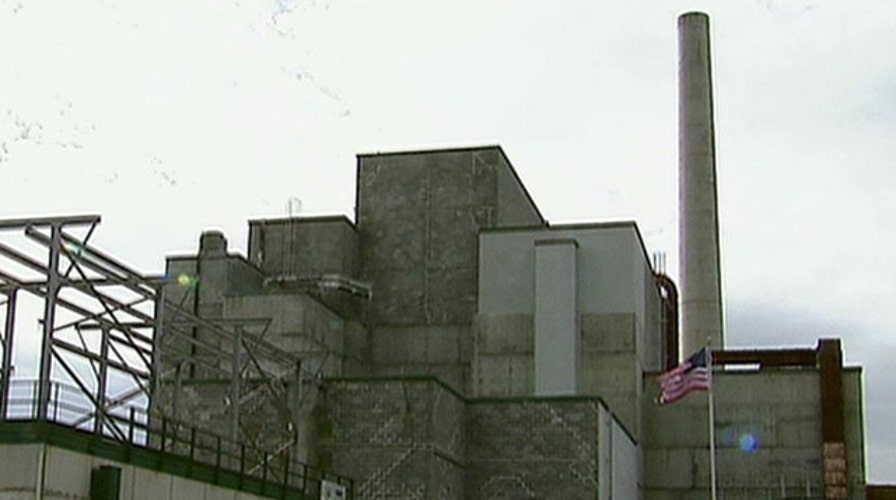YAKIMA, Wash. – Six underground tanks holding a mix of radioactive and toxic waste are leaking at America’s most contaminated nuclear site in Washington, federal and state officials say, posing an eventual risk to groundwater and rivers.
The leaking materials at Hanford Nuclear Reservation are no immediate threat to public safety or the environment because it would take perhaps years for the chemicals to reach groundwater, Washington Gov. Jay Inslee said Friday. So far, nearby monitoring wells haven't detected higher radioactivity levels.
But the leaks have renewed discussion over delays for emptying the tanks, which were installed decades ago and are long past their intended 20-year life span.
"None of these tanks would be acceptable for use today. They are all beyond their design life. None of them should be in service," said Tom Carpenter of Hanford Challenge, a Hanford watchdog group. "And yet, they're holding two-thirds of the nation's high-level nuclear waste."
Suzanne Dahl, the tank waste treatment manager for the Washington Department of Ecology, told Reuters that four of the tanks have leaked in the past.
"It points to the age of the tanks and how there's going to be an increased probability of this happening in the future," she said. "When waste is in the tanks, it's manageable. Once it's out of the tanks and in the soil, it's much harder to manage it, remove it, and down the road you're adding to contamination in the groundwater that already exists."
Just last week, state officials announced that one of Hanford's 177 tanks was leaking 150 to 300 gallons a year.
Inslee then traveled to Washington, D.C., to discuss the problem with federal officials, learning in meetings Friday that six tanks are leaking.
The declining waste levels in the six tanks were missed because only a narrow band of measurements was evaluated, rather than a wider band that would have shown the levels changing over time, Inslee said.
"It's like if you're trying to determine if climate change is happening, only looking at the data for today," he said. "Perhaps human error, the protocol did not call for it. But that's not the most important thing at the moment. The important thing now is to find and address the leakers."
Department of Energy spokeswoman Lindsey Geisler said there was no immediate health risk and that federal officials would work with Washington state to address the matter.
Regardless, Sen. Ron Wyden, the new chairman of the Senate Energy and Natural Resources Committee, will ask the Government Accountability Office to investigate Hanford's tank monitoring and maintenance program, said his spokesman, Tom Towslee.
The federal government built the Hanford facility at the height of World War II as part of the Manhattan Project to build the atomic bomb. The remote site produced plutonium for the bomb dropped on Nagasaki, Japan, and continued supporting the nation's nuclear weapons arsenal for years.
Today, it is the most contaminated nuclear site in the country, still surrounded by sagebrush but with Washington's Tri-Cities of Richland, Kennewick and Pasco several miles downriver.
Several years ago, workers at Hanford completed two of three projects deemed urgent risks to the public and the environment, removing all weapons-grade plutonium from the site and emptying leaky pools that held spent nuclear fuel just 400 yards from the river.
But successes at the site often are overshadowed by delays, budget overruns and technological challenges. Nowhere have those challenges been more apparent than in Hanford's central plateau, home to the site's third most urgent project: emptying the tanks.
Hanford's tanks hold some 53 million gallons of highly radioactive waste -- enough to fill dozens of Olympic-size swimming pools -- and many of those tanks are known to have leaked in the past. An estimated 1 million gallons of radioactive liquid has already leaked there.
The cornerstone of emptying the tanks is a treatment plant that will convert the waste into glasslike logs for safe, secure storage. The plant, last estimated to cost more than $12.3 billion, is billions of dollars over budget and behind schedule. It isn't expected to being operating until at least 2019.
Washington state is imposing a "zero-tolerance" policy on radioactive waste leaking into the soil, Inslee said. So given those delays and the apparent deterioration of some of the tanks, the federal government will have to show that there is adequate storage for the waste in the meantime, he said.
"We are not convinced of this," he said. "There will be a robust exchange of information in the coming weeks to get to the bottom of this."
Inslee and Oregon Gov. John Kitzhaber, both Democrats, have championed building additional tanks to ensure safe storage of the waste until the plant is completed.
Wyden, D-Ore., toured the site earlier this week. He said he shares the governors' concerns about the integrity of the tanks but he wants more scientific information to determine it's the correct way to spend scarce money.
Wyden noted the nation's most contaminated nuclear site -- and the challenges associated with ridding it of its toxic legacy -- will be a subject of upcoming hearings and a higher priority in Washington, D.C.
The federal government already spends $2 billion each year on Hanford cleanup -- one-third of its entire budget for nuclear cleanup nationally. The Energy Department has said it expects funding levels to remain the same for the foreseeable future, but a new Energy Department report released this week calls for annual budgets of as much as $3.5 billion during some years of the cleanup effort.
There are legal, moral and ethical considerations to cleaning up the Hanford site at the national level, Inslee said, adding that he will continue to insist that the Energy Department completely clean up the site.
The Associated Press contributed to this report.


